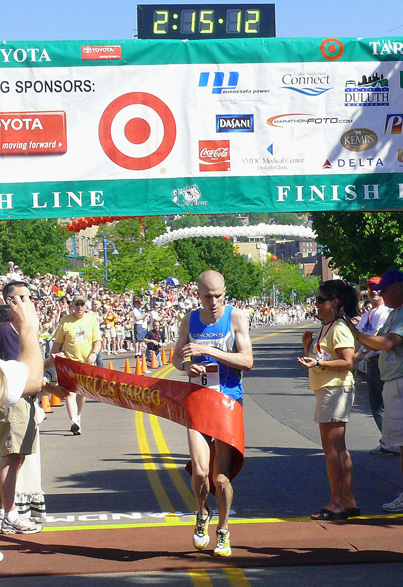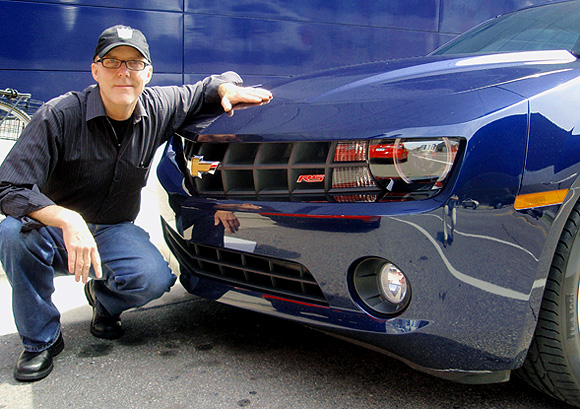Chief designer of new Camaro brings one back home
Tom Peters came home last week, and he brought a couple of his latest works of art with him. He also brought his son, so he could show him the places he used to live in the Minneapolis suburb of Deephaven, with the family moving to nearby Chaska when he was 13.
“We used to play hockey on Lake Minnetonka, and I’ve been telling my son about it,” said Peters. “He’s playing now in the Detroit area, but he’s never played outdoors.”
When Peters was in school, and maybe his mind would wander into daydreams, he would draw things. He saved one of them and reproduced it, and I was flattered that he gave me a print. It is a drawing of a hot-rod, one of those high-up vehicles that used to be the favorite style of hot-rod magazine cartoonists, and it was of a modified 1969 Chevrolet Camaro.
The significance of that is that the pieces of art Peters brought home to put on display in Minneapolis were a pair of 2010 Camaros, one dark red and the other dark blue — vehicles whose design was the responsibility of Peters. There is no doubt about the connection Peters enforced with the concept car, and, more important, to the classic vintage 1996 model.
Both of the new cars had 3.6-liter V6 engines and were RS models that drove smoothly in a brief whirl up the freeway and back to the Guthrie Theater. The big Corvette 6-liter V8 has been popular with first buyers, but after the muscle-car surge, Chevrolet anticipates the potent and high-tech V6 will become the dominant choice in the car. Read more
Raabe comes home, makes Grandma’s his 1st win
 DULUTH, MINN.—Christopher Raabe didn’t plan to break out in front of the field at Grandma’s Marathon Saturday, because setting a fast early tempo along Highway 61’s North Shore Drive invariably leads to a fade later in the race. It would be especially faulty this year, because it was too hot, and far too humid.
DULUTH, MINN.—Christopher Raabe didn’t plan to break out in front of the field at Grandma’s Marathon Saturday, because setting a fast early tempo along Highway 61’s North Shore Drive invariably leads to a fade later in the race. It would be especially faulty this year, because it was too hot, and far too humid.
And yet, Raabe had to smile at the irony, because he did exactly what he didn’t intend to do, and won his first marathon because of it.
Raabe only intended to keep pace with a couple of African runners who broke ahead near the halfway point, he said, adding that he was surprised when he noticed a gap to the rest of over six thousand runners. More surprising, he somehow steadily extended his lead, and by the time he ran smoothly to the Canal Park finish line, Chris Raabe had won by a margin of three minutes and 23 seconds.
His time was 2 hours, 15 minutes, 13 seconds — a personal best — and he became the first Minnesotan to win Grandma’s since Dick Beardsley set the all-time Grandma’s record in 1982.
Charles Kanyao was second, leading the crew of hired-in African runners who normally dominate Grandma’s. As the temperature rose toward the 80s, catching a humidity figure already that high, the biggest news of the day was that a Minnesota native enjoyed the sweltering heat while some of Kenya’s top distance runners faded and faltered from weather better suited to the crowd that lined the 26.2-mile course starting at Two Harbors.
The weather also affected the women. Mary Akor collapsed into a wheelchair as soon as she staggered a bit after the finish line, but she won her third consecutive women’s title in 2 hours, 36 minutes and 52 seconds. Akor, a naturalized U.S. citizen from Nigeria, said she loves to run in hot weather, but she held on to win by six seconds — the second-closest women’s finish — because she knew “they’d have to revive me anyway.”
By winning, Akor duplicated the three-straight women’s titles of Lorraine Moller, an Olympian from New Zealand who ran — and won — her first marathon at Grandma’s in 1979, setting a record of 2:37:37. Moller went on to win seven consecutive marathons, returning to dominate Grandma’s. Akor was inspired to match Moller by dedicating her run to her father, who died unexpectedly in Nigeria last week.
While exhaustion slowed most of the runners, Raabe, who was born in Tyler, Minnesota, seems to have a lasting appreciation for the heat. “I’m always cold,” said Raabe, wearing what may have been the only knit cap in Canal Park over his close-shaved head after the run. That was a tip to his comfort level, possibly traceable to his chilly springs running track at Sauk Rapids High School, and later at North Dakota State University.
The Raabe family moved to Washington, D.C., where Chris is a patent examiner. He runs the streets of the nation’s capitol, including the monument-lined area near the White House. He insists he’s too old, at 30, to think about becoming a professional runner, and he’s quick to claim he was never a top track athlete, even though he reached the state track meet once. He said he decided to try marathons because “I couldn’t keep running 5K or 10K…I was too slow.”
Raabe’s first victory came in only his sixth marathon — half of which have been Grandma’s. Two years ago he was 12th, last year he was sixth, but he had no illusions of winning in his third try, over the course he used to visit while watching his dad run. In a role reversal, Bill Raabe ran the preliminary Garry Bjorklund Half-Marathon before witnessing his son’s fantastic feat. But as for his winning “strategy?” Forget it.
Chris Raabe said that when two African runners broke away, just before the halfway mark, he decided to go with them. After he edged ahead, he said, “I looked around, expecting to find one or both of them within 10 yards or so. When I noticed there was a gap, I thought I’d try to see how long I could maintain it.”
Kanyeo said he noticed when Raabe and the others moved ahead but chose to stay conservative. “I stayed with the pack,” Kanyeo said, “because they were going too fast. I was sure they couldn’t keep up that pace.”
{IMG2}
Raabe said staying in the pack was the better strategy. “That makes sense, to stay in the group that early in the race,” said Raabe. “You can be up by a few minutes and come back quickly. But when I saw I was alone, I thought, ‘Why not?’ I figured I might start slowing up, but I hoped I’d have enough of a gap. I kept waiting for the push to come.”
But he never heard the footsteps he anticipated, because the push from the lean, swift group of African runners never materialized. Not that Raabe knew how large a lead he had as he ran through downtown Duluth.
“You don’t want to look back too much,” he said. “It gives the guys behind you the idea that you might be having trouble. I was hoping that if anyone caught up to me, it would only be two or three. When I got to the Radisson, and turned down the hill, I looked back.”
And he saw — nothing. By then his lead had gone from a minute, to two minutes, to two and a half minutes. As he made the turn at the Radisson to head down Fifth Avenue West toward the harbor, Raabe said, “All I thought was that it was nice I only had a mile to go.”
Raabe didn’t falter. When he made the final turn and headed for Canal Park, many in the crowd chanted “USA…USA…” as the slim, 5-foot-11, 125-pound Raabe headed for the finish to become the first U.S. native winner since Mark Curp claimed Grandma’s in 1985.
Akor said she almost bypassed Grandma’s when her father died unexpectedly in Nigeria. Instead, she dedicated her try for her third consecutive Grandma’s title to her father, and the oldest of nine children was scheduled to fly to Nigeria for the funeral.
Akor battled Janet Cherobon of Kenya as her prime challenger, and said she told herself she had to stay ahead of her. As Akor led the way toward the finish, she saw Alina Ivanova was closing in. “I said, ‘Oh, no!’ ” But again she summoned all her strength, veering slightly as she hit the finish line six seconds ahead of her Russian pursuer. She said she had trouble locating the finish line, and asked where Cherobon had finished. Cherebon had collapsed on the course about 100 yards from the end and had to be brought to the finish by wheelchair.



 John Gilbert is a lifetime Minnesotan and career journalist, specializing in cars and sports during and since spending 30 years at the Minneapolis Tribune, now the Star Tribune. More recently, he has continued translating the high-tech world of autos and sharing his passionate insights as a freelance writer/photographer/broadcaster. A member of the prestigious North American Car and Truck of the Year jury since 1993. John can be heard Monday-Friday from 9-11am on 610 KDAL(www.kdal610.com) on the "John Gilbert Show," and writes a column in the Duluth Reader.
John Gilbert is a lifetime Minnesotan and career journalist, specializing in cars and sports during and since spending 30 years at the Minneapolis Tribune, now the Star Tribune. More recently, he has continued translating the high-tech world of autos and sharing his passionate insights as a freelance writer/photographer/broadcaster. A member of the prestigious North American Car and Truck of the Year jury since 1993. John can be heard Monday-Friday from 9-11am on 610 KDAL(www.kdal610.com) on the "John Gilbert Show," and writes a column in the Duluth Reader.